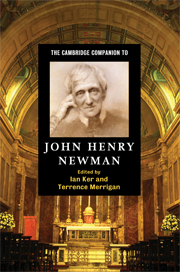7 - The Church as communion
Published online by Cambridge University Press: 28 May 2009
Summary
Two years before the beginning of the Oxford Movement, Newman dismissed the idea of an individualistic Christianity. Any Christian who 'stands forth on his own ground, declaring himself as an individual a witness for Christ', would be 'grieving and disturbing the calm spirit given us by God', for Christians are called to 'unite together in one, and to shelter our personal profession under the authority of the general body'. Two years later in 1833, the year Newman regarded as the formal beginning of the Movement, he is sure that you cannot separate Christianity from the Church: 'The Holy Church has been set up from the beginning as a solemn religious fact . . . as a picture, a revelation of the next world, as itself the Christian Dispensation'. Rejecting his former Evangelical conception of the real Church as invisible, the Tractarian Newman insisted that the Church 'is a visible body, and, to appearance, an institution of this world'. For it is a 'Kingdom which Christ has set up', or, rather, 'a new Kingdom has been established, not merely different from all kingdoms before it, but contrary to them; a paradox in the eyes of man, - the visible rule of the invisible Saviour'. But although this visible communion has an institutional and regal aspect, nevertheless it is fundamentally sacramental: 'Christ formed a body. He secured that body from dissolution by the bond of a Sacrament. He committed the privileges of His spiritual kingdom and the maintenance of His Faith as a legacy of this baptized society.'
- Type
- Chapter
- Information
- The Cambridge Companion to John Henry Newman , pp. 137 - 155Publisher: Cambridge University PressPrint publication year: 2009
- 3
- Cited by

